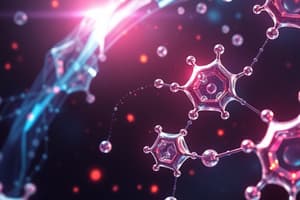Podcast
Questions and Answers
What is of special importance in drug-receptor interaction?
What is of special importance in drug-receptor interaction?
- Hydrophobicity and hydrophilicity
- pH and temperature
- Molecular weight and solubility
- Electronic charge distribution and conformation (correct)
What factors does the activity of drugs depend on?
What factors does the activity of drugs depend on?
- Boiling point, melting point, and density
- Solubility, reactivity, and odor
- Molecular structure, color, and taste
- Stereochemistry, distance between atoms or groups, electronic distribution and configuration (correct)
What is critical for optimal biological activity in certain drugs?
What is critical for optimal biological activity in certain drugs?
- Molecular size and shape
- Chemical stability in different pH environments
- Distances between the functional groups (correct)
- Presence of aromatic rings
What is the receptor usually composed of?
What is the receptor usually composed of?
What type of substances contain common functional moieties arranged in space in an analogous manner?
What type of substances contain common functional moieties arranged in space in an analogous manner?
What is of fundamental importance for the interaction of the drug with the receptor?
What is of fundamental importance for the interaction of the drug with the receptor?
What are two values of special importance in drug-receptor interaction?
What are two values of special importance in drug-receptor interaction?
What is a limited portion of a macromolecule, usually protein in nature, where a drug interacts?
What is a limited portion of a macromolecule, usually protein in nature, where a drug interacts?
What structural factors does the activity of drugs depend on?
What structural factors does the activity of drugs depend on?
What is critical for optimal biological activity in certain drugs?
What is critical for optimal biological activity in certain drugs?
Flashcards are hidden until you start studying
Study Notes
Drug-Receptor Interaction
- Drug-receptor interaction is essential for understanding how drugs elicit their effects in the body.
- The activity of drugs is influenced by various factors including chemical structure, binding affinity, and the environment in which the drug acts.
Factors Affecting Drug Activity
- The structural characteristics of the drug, such as size, shape, and polarity, play a significant role in its activity.
- The presence of specific functional groups or moieties on the drug molecule can enhance or inhibit its interaction with receptors.
Optimal Biological Activity
- Certain drugs require a specific orientation of atoms and functional groups for optimal biological activity, often termed stereochemistry.
- Proper fitting of the drug into the receptor site is critical, analogous to a key fitting into a lock.
Receptor Composition
- Receptors are typically proteins that may be composed of various amino acids.
- The three-dimensional structure of receptors allows for precise interactions with corresponding drugs.
Common Functional Moieties
- Substances with similar pharmacological effects often contain analogous functional moieties, arranged spatially in comparable manners.
- These functional moieties dictate how well a drug can bind to its receptor and elicit a response.
Importance of Binding and Affinity
- Binding affinity and intrinsic efficacy are two crucial values that dictate the strength and effectiveness of drug-receptor interactions.
- High binding affinity often leads to better therapeutic outcomes.
Binding Site Characteristics
- The binding site on a macromolecule, usually a protein, is a limited portion where the drug interacts.
- This site is often characterized by specific physical and chemical properties that complement the drug structure.
Structural Factors Influencing Drug Activity
- The stereochemical configuration, molecular weight, and electronic properties influence how drugs interact with receptors.
- Structural modifications can lead to variations in drug potency and therapeutic effects.
Studying That Suits You
Use AI to generate personalized quizzes and flashcards to suit your learning preferences.




